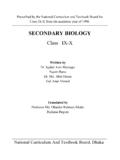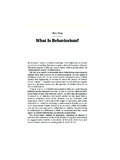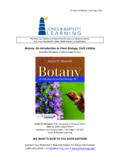Transcription of AQA GCSE Biology B1 six mark questions
1 AQA GCSE Biology B1 six mark questions In GCSE specifications that require candidates to produce written material in English, candidates must do the following: ensure that text is legible and that spelling, punctuation and grammar are accurate so that meaning is clear select and use a form and style of writing appropriate to purpose and to complex subject matter organise information clearly and coherently, using specialist vocabulary when appropriate. In these questions , students are required to produce extended written material in English, and will be assessed on the quality of their written communication as well as the standard of the scientific response. Students will be required to: - use good English - organise information clearly - use specialist vocabulary where appropriate.
2 The following general criteria should be used to assign marks to a level: Level 1: Basic Level 2: Clear Level 3: detailed Knowledge of basic information Knowledge of accurate Knowledge of accurate Simple understanding information information appropriately The answer is poorly organised, Clear understanding contextualised with almost no specialist terms The answer has some structure Detailed understanding, and their use demonstrating a and organisation, use of supported by relevant evidence general lack of understanding specialist terms has been and examples of their meaning, little or no attempted but not always Answer is coherent and in an detail. accurately, some detail is given organised, logical sequence, The spelling, punctuation and There is reasonable accuracy in containing a wide range of grammar are very weak.
3 Spelling, punctuation and appropriate or relevant grammar, although there may specialist terms used still be some errors. accurately. The answer shows almost faultless spelling, punctuation and grammar. The following information applies to all questions In this question you will be assessed on using good English, organising information clearly and using specialist terms where appropriate. Keeping Healthy a) We need a balanced diet to keep us healthy. Explain the ways in which an unbalanced diet can affect the body. Nelson Thornes (end of chapter questions ). b) Antibiotic-resistant bacteria can cause infection outbreaks in hospitals. Strict hygiene procedures are enforced to try to restrict the spread of infection between patients. Explain how antibiotic-resistant bacteria develop, and why they are such a problem in hospitals.
4 Describe some steps which are being taken to try to prevent the development of resistant strains. Kerboodle B1 Extension c) A student is given a tube containing a liquid nutrient medium. The medium contains one type of bacterium. The student is told to grow some of the bacteria on agar jelly in a Petri dish. Describe how the student should prepare an uncontaminated culture of the bacterium in the Petri dish. You should explain the reasons for each of the steps you describe. AQA Biology Unit 1 January 2013. Nerves and Hormones d) Reflex actions are one way the body responds to changes in its environment. Using appropriate examples, describe how the nervous system is involved in the stages of a reflex action. Kerboodle B1 Extension e) A person accidentally touches a hot pan.
5 Her hand automatically moves away from the pan. The diagram shows the structures involved in this action. Describe fully how the structures shown in the diagram bring about this reflex action. AQA Science A, unit 5H specimen paper f) Plants respond to light and gravity. Describe how plant hormones control the growth of roots and shoots. Nelson Thornes (end of chapter questions ). Drugs g) Read the information below: Total cholesterol in the blood contains good' and bad' cholesterol. High levels of bad' cholesterol increase the risk of heart disease. High levels of good' cholesterol reduce the risk of heart disease. Scientists have suggested that chemicals called polyphenols in dark chocolate may help people with Type 2 diabetes. Polyphenols may reduce high levels of bad' cholesterol in the blood.
6 The scientists investigated the effect of polyphenols on levels of cholesterol in the blood. 7 men and 5 women with Type 2 diabetes had the levels of cholesterol in their blood measured. They all ate 45 g of dark chocolate every day for 16 weeks. 6 of the people ate dark chocolate that contained polyphenols. The other 6 people ate dark chocolate that did not contain polyphenols. All 12 people were allowed to eat and drink anything else they wanted, but no more chocolate. The levels of cholesterol in their blood were measured again after 16 weeks. The results showed that for the people who ate dark chocolate with polyphenols: - there were decreases in total cholesterol and bad' cholesterol - there was an increase in good' cholesterol. A newspaper headline reported the research and wrote: Research shows that diabetics should eat dark chocolate.
7 '. Was the newspaper's statement justified? Include in your answer evidence that supports the newspaper's statement and evidence that does not support the newspaper's statement. Remember to give a conclusion to your answer. AQA Science A, Unit 5 January 2012. Interdependence and Adaptation h) The drawing shows the shapes of trees growing on their own and inside a forest. The trees are of the same species. Describe the differences between the tree growing on its own and the trees inside the forest. Suggest reasons for the differences you have described. AQA Science A Route 2, unit 6H (June 2012). i) Plants and animals have become adapted in many different ways to reduce the risk of being eaten by predators. Describe these adaptations. Give examples of animals and plants adapted in the ways you describe.
8 AQA Biology Unit 1 June 2012. Energy and Biomass in food chains j) The diagram shows a food web for some of the organisms that live on moorland. Only a small percentage of the Sun's energy captured by the heather is eventually incorporated into the body tissues of the fox. Explain, as fully as you can, what happens to the rest of the energy captured by the heather. AQA Biology unit 1 Specimen paper Waste materials in plants and animals k) The constant cycling of carbon in nature is called The carbon cycle'. Each autumn, trees lose their leaves. Describe how the carbon in the leaves is recycled so that the trees can use it again. Nelson Thornes (end of chapter questions ). l) The diagram shows part of the carbon cycle. Use the information in the diagram and your own knowledge to describe in detail how carbon is cycled between living organisms and the air.
9 Your answer should include the names of any processes involved. AQA Science A Route 2, Unit 6H (January 2012). Genetic variation and its control a m) Describe the differences between sexual and asexual reproduction. Name an organism that reproduces sexually and name an organism that reproduces asexually. Kerboodle B1 extension c n) To try to help feed the world's increasing population, scientists have developed genetically modified (GM). crops. Describe how genetically modified crops are produced. Give an advantage and a disadvantage of growing genetically modified crops. Keboodle B1 Extension Evolution o) Most scientists now believe that new species arise as a result of evolution. This theory was first proposed by Darwin in 1859. At that time many people did not agree with his views.
10 Explain what is meant by the theory of evolution and why it has taken time for people to accept this theory. Kerboodle B1 extensio







